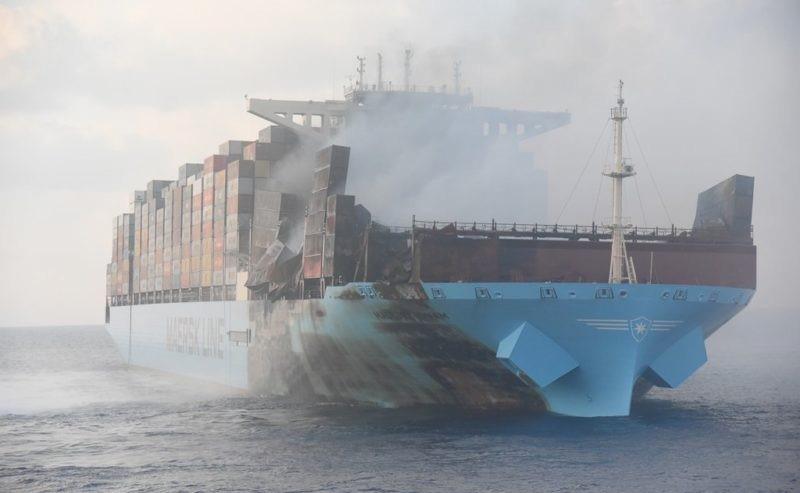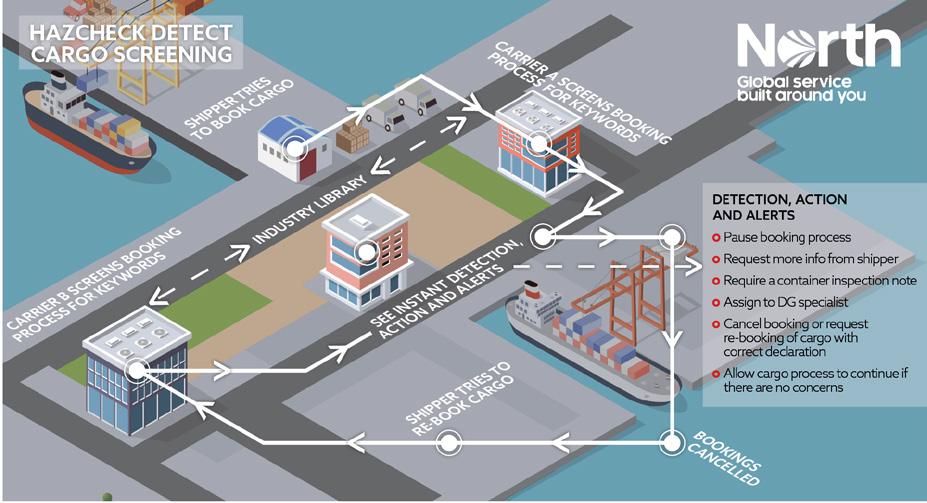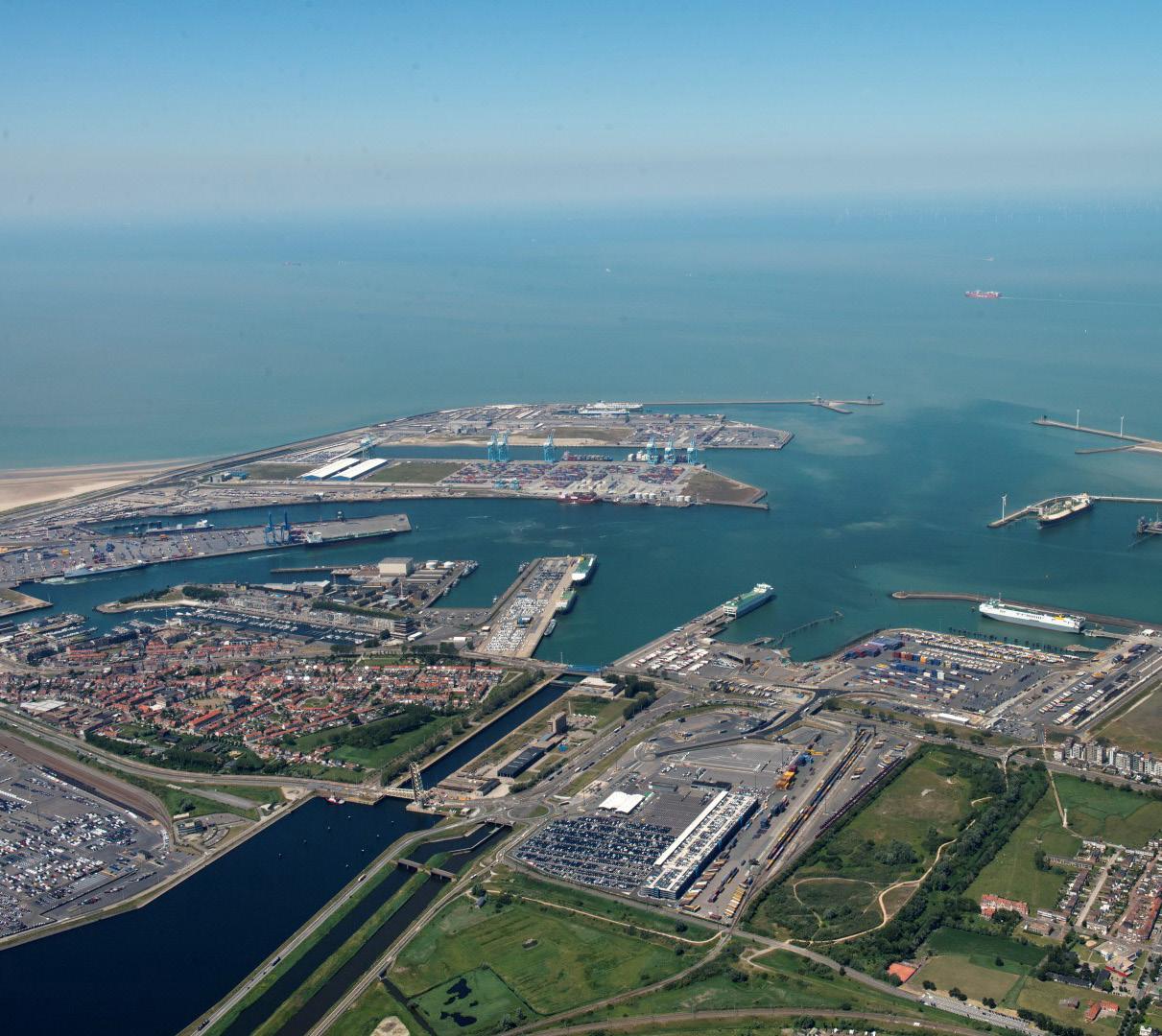
7 minute read
Dangerous Goods
TAKE A HOLISTIC APPROACH
The National Cargo Bureau presents a holistic approach to the growing challenge of mis-declared and undeclared dangerous goods
Ports are an integral part of the movement of dangerous goods by sea, the place where millions of TEU around the globe come together each year to begin their journey on water to reach their final destination. Ports and terminals vary in size and capability including adoption of automation and strategic importance. Actions taken at this stage of a journey can be crucial in ensuring that the dangerous goods (DG) carried in containers (approximately 10 per cent of all containers shipped) reach their respective destinations safely and without incident out at sea.
In 2020, New York based cargo inspection company, National Cargo Bureau (NCB), published a white paper calling for urgent reform to stem the increasing number of containerrelated incidents caused by undeclared or misdeclared dangerous cargoes.
The White Paper was written in response to a Container Inspection Safety Initiative carried out by NCB following the Maersk Honam explosion in 2018. NCB carried out 500 free inspections of a sample of containers at US ports, including imports (which would not normally be part of NCB’s remit), for members of the Cargo Incident Notification System (CINS). The inspection revealed an alarming number of containers carried by sea include mis-declared dangerous cargoes that represent a serious safety risk to port/terminal staff, crew, vessel and the environment.
Of the 500 containers inspected, 55 per cent failed with one or more deficiencies; 69 per cent of the import containers containing dangerous goods failed; and 38 per cent of containers with dangerous goods exports failed.
Of the import containers with dangerous goods, 44 per cent had problems with the way cargo was secured, 39 per cent had improper placarding and 8 per cent had misdeclared cargo. Of the export containers with dangerous goods, 25 per cent had securing issues, 15 per cent were improperly placarded and 5 per cent were mis-declared.
The problem of incidents in ports or at sea is not going away. Container ships are getting larger, and the increasing number of containers means the risk is getting greater. As a result, the problem of undeclared and mis-declared dangerous goods cargo continues to grow. To tackle this issue, a comprehensive holistic approach needs to be adopted by the industry to minimise non-compliance by all supply chain participants.
WHAT IS CAUSING THE ISSUE? Regulations and compliance
Regulations governing the transportation of dangerous goods were developed to protect life, property and the environment. They impose specific obligations and requirements for all supply chain participants. Each participant must rely on the others to fulfil their obligations or overall supply chain safety will be compromised.
The IMDG Code, produced by the International Maritime Organisation is a detailed set of requirements covering the transport of packaged dangerous goods by sea. An increase in players in the supply chain and demands for faster, just-intime deliveries have created complex supply chains. Many organisations offer insufficient training and there is inadequate knowledge of dangerous goods and how they should be shipped.
Limiting the movement of DG
Limits and bans by ports/terminals on which dangerous goods can enter or transit a port can lead to wilful misdeclaration. For example, high demand for calcium hypochlorite which has been implicated in several high profile container vessel fires, can lead to misdeclaration if shippers try to cut corners. The tightening of DG guidelines at ports following the Tianjin incident in 2015 also had a similar effect.
8 A serious incident
- the Maersk Honam caught fire on 6 March 2018 while sailing in the Arabian Sea
Vessel sharing and complex supply chains
Vessel sharing agreements and carrier alliances mean different versions of port/terminal restrictions can be in play (there is not a single consistent database of port and terminal DG restrictions). In addition, more complex supply chains have evolved with carriers including door-to-door solutions including freight forwarding, warehousing, consolidation and other logistics services as well as ocean transportation.
Internal pressures
Port and terminal operators and vessel operators have developed processes and procedures for the review, approval, acceptance and carriage of dangerous goods. However, resources, tools, processes/procedures and training can vary greatly and may not be in line with industry best practice. DG legacy systems and a lack of consistent connected DG data can lead to incomplete documentation, improper vessel stowage and/or segregation of DG cargoes. In the case of undeclared or mis-delcared DG the problem becomes much worse and the risk multiplies.
The recommendations
NCB’s white paper is calling for industry to adopt a comprehensive, holistic and coordinated approach to address the worrying trend of mis-declared and undeclared DG with 12 recommendations including the establishment of a corporate culture for DG compliance with a dedicated DG

department, a centralised DG database; an effective DG documentation and planning process, a robust DG container and vessel inspection programme, the use of digital tools to automate critical compliance functions and a compliant DG training programme.
HOW CAN PORTS AND TERMINALS HELP?
Ports and terminals are the interface between ship and shore, and activities need to be coordinated effectively to prevent major accidents. There are some measures that can be taken to improve safety on a port-wide basis.
5 Improve knowledge with the implementation of an effective
IMDG Code training programme – all players within a port environment should have knowledge of the IMDG Code appropriate to the role that they have within the organisation. Those shore side roles range from officebased positions, where a limited amount of knowledge is required, through to hands on roles like stevedores and vessel planners.
5 Encourage the implementation of digital tools to improve shipping practices 6 Verify declared dangerous goods cargo passing through the ports complies with the latest IMDG Code regulations 6 Inform the industry of any local port/terminal DG restrictions contributing to a consistent and industry standard database of such restrictions 6 Identify mis-declared or undeclared dangerous goods before they are loaded onto vessels 6 Ensure that dangerous goods have correct placards and are stowed correctly in the container yard/on the vessel.
DIGITAL TOOLS AND TRAINING
As part of their mission of Safety of Life and Cargo at Sea, the NCB Group, comprising the National Cargo Bureau and subsidiary Exis Technologies, have developed several digital tools and an e-learning regulatory training programme to help.
Hazcheck Restrictions – a web-based database and access portal to allow port and terminals to share any local DG restrictions or prohibitions with trading partners such as container lines.
Hazcheck Web Service - a set of dangerous goods data packages and routines for incorporation into cargo booking, handling, ERP and planning systems. Includes segregation, stowage and packaging checks.
Hazcheck Detect –a cargo screening tool that detects misdeclared and undeclared dangerous goods in containerised shipments. Allows non-compliant cargo to be detected within seconds rather than days. Last minute changes to bookings can be picked up in real time so problematic cargo is not loaded onto the ship.
Hazcheck Inspections – a web-based container inspections database and access portal to allow inspection companies to plan and enter details of cargo inspections completed on behalf of port, container or vessel operators. Remote container inspections are also available via a mobile device with an option for live access to an NCB Surveyor.
IMDG Code e-learning Amendment 40-20 - mandatory online training for all shore side staff involved in the handling and transport of dangerous goods by sea. IMDG Code e-learning is a certified Det Norske Veritas Learning Programme.
WE ALL HAVE A PART TO PLAY
All of the players in the supply chain have a part to play in the shipment of dangerous goods by sea. By taking effective measures at each stage of the chain, incidents can be prevented, lives saved and the environment can be protected for future generations.
The NCB White Paper, “A Comprehensive Holistic Approach to Enhance Safety and Address the Carriage of Undeclared, Mis-declared and other Non-compliant Dangerous Goods” can be found here: https://www.natcargo.org/Holistic_ Approach.html
8 The Hazcheck
Detect cargo screening tool for misdeclared and undeclared dangerous goods currently screens approximately 15 million requests monthly, identifying between 500-1000 hits a day. This prevents 40-50 high risk containers per week being loaded onto vessels. The numbers will grow as more shipping lines adopt the tool, further decreasing incidents at sea. Maersk, ONE, Hapag Lloyd and Pacific International Lines are currently customers
Bruges Meeting & Convention Centre, Bruges • Belgium

Host Port:
Conference Programme

Green Solutions for Sustainable Ports by 2030
Sponsored by: Supported by:
Balancing Environmental Considerations with Economic Demands. The world’s leading conference on sustainable environmental practice comes to Bruges. Join us for two days of conference presentations and learn from the foremost experts in environmental technologies
visit: https://www.portstrategy.com/greenport-cruise-and-congress contact: +44 1329 825335 email: congress@greenport.com
Media Partners:








